THE FORTH GLOBAL INTERACTIVE
FORUM ON TRAFFIC & SAFETYEvent
Thank you so much for your participation in the Symposium on 2nd November, 2018.
Outline
| Title: | THE FOURTH GLOBAL INTERACTIVE FORUM ON TRAFFIC & SAFETY |
| Venue: | U Thant International Conference Hall(3F), United Nations University, 5-53-70 Jingumae Shibuya-ku, Tokyo 150-8925, Japan |
| Date: | Friday, November 2, 2018 |
| Host: | International Association of Traffic and Safety Sciences (IATSS) |
Opening Address
Kazuhiko Takeuchi
IATSS President
Institute for Global Environmental Strategies (IGES)
Project Professor, the University of Tokyo
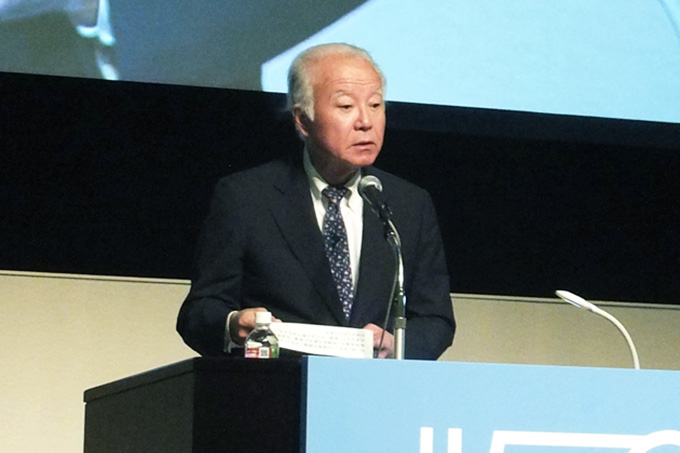
Prof. Kazuhiko Takeuchi, President of the International Association of Traffic and Safety Sciences (IATSS), opened the fourth Global Interactive Forum on Traffic and Safety (GIFTS) of 2018 by expressing his appreciation to the speakers, panel, and guests for their participation along with the affiliated organizations. IATSS has engaged in investigations of traffic safety for the past 40 years and seen drastic change in the field.
Currently, traffic deaths per annum exceed 1.2 million thus it represents a significant global challenge especially for emerging markets, along with other major international issues such as climate change, sustainable city development, gaps in society, etc. Global safety, traffic culture, transdisciplinarity, and collaboration are the four perspectives being addressed by IATSS with the social and cultural background of traffic safety being the topic of this forum.
IATSS will also operate in a transdisciplinary fashion to share the spread of knowledge. Collaboration and sharing of these global challenges will benefit global traffic safety.
Objective Description
Takashi Oguchi
IATSS Member/Chairman, International Forum Committee
Professor, Institute of Industrial Science, the University of Tokyo
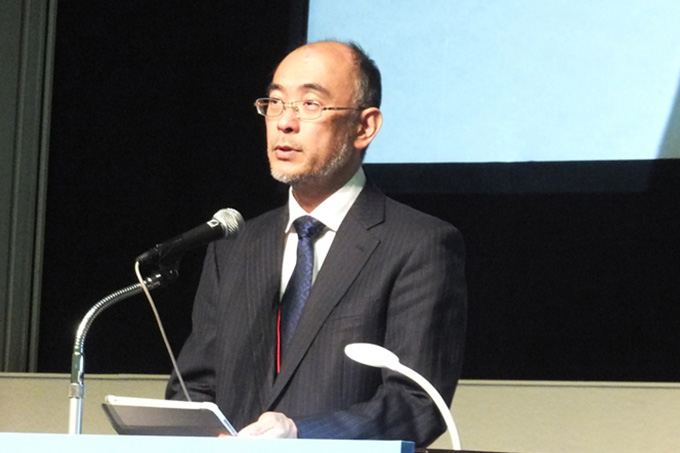
Prof. Takashi Oguchi, Chairman of International Forum Executive Committee, started proceedings by describing that the four basic IATSS principles and its transdisciplinary approach should benefit all the stakeholders of traffic safety. He then described the topics tackled at GIFTS in the previous years including: designing holistic road safety, the historic evolution of the transport networks of major cities, a new stage aiming for Vision Zero, and the reports from these respective countries.
Prof. Oguchi introduced the speakers on the panel and the topics they will be discussing during the symposium include; public space in traffic culture, space design, the difference in traffic culture, and streets being a public space.
Keynote Address
Terunobu Fujimori
Architectural historian / Architect
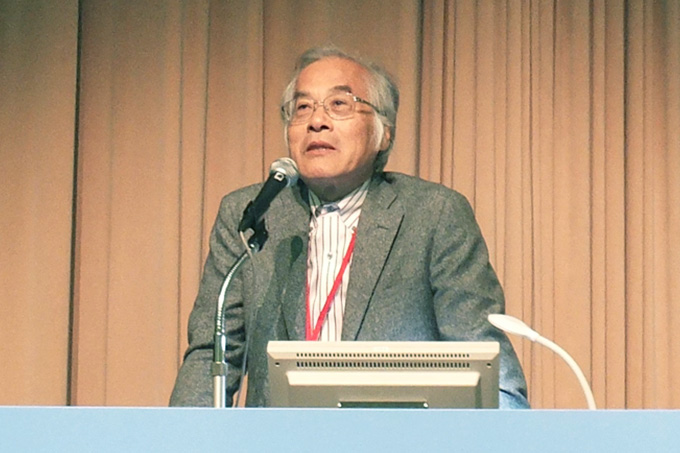 |
 |
Dr. Terunobu Fujimori, the Director of The Tokyo Metropolitan Edo-Tokyo Museum, began by addressing that road and traffic safety might reflect the cultures of the society that they inhabit. He has a fond interest in observing many fascinating phenomena on the street, and thus created a group called Rojo. The members of the Rojo society independently began observing streets in the 1970s. Dr. Fujimori continued by showing the members photographs from throughout the years.
The photos of the Rojo group included the scenes of manmade manholes which caught the group’s particular attention, along with animals in the street. Other manmade elements were shown such as a stairway that leads to nowhere. The group also found a sort of replica of Hokusai’s views of Mount Fuji through the representation of Mount Fuji in window frames, postboxes, children’s playgrounds, gates and walls, etc. Another manmade feature that was of note was “sandwich houses” which are small traditional buildings trapped between high-rise modern buildings. The photos showed many other idiosyncrasies of architecture in Japan.
Nature was an additional topic investigated by Rojo. Plants were shown to overgrow certain architectural pieces, with some houses completely taken over by vines. The Japanese culture of bonsai can also be seen in the shaping trees in the streetscape. Other times, nature itself creates almost architectural forms of trees through wind or other natural processes. The residents of Japan often plant small trees on the street, inside shoes, kettles and taps. Growing plants in public spaces a common habit in Japan and can be seen, even in drains and bicycles. The waterside is also a place of creativity and interest, with many taps and spouts being used to direct water.
The exposition of the Rojo group’s efforts show that mailboxes, and houses did not escape the creative endeavors of their owners. There are stairways with disappearing steps, and painted lines which follow the roadside but stop nowhere or create interesting patterns. Other Japanese homeowners put their creative endeavors towards painting stone bollards. Photographers of the Rojo group highlighted shadows, remnants of old street items, or houses which show links to past. Contemporary art can also be seen on the streets, scenes reminiscent of famous works of contrasting colors and strange abstract scenes.
These activities of the Rojo and others discovered unique aspects of the streets rarely noticed by others as we go about our daily lives distracted in the streets. Paying attention to ordinary things on the street was started by Wajiro Kon in the 1920s. Kon, an architect started as a designer, but gradually changed to studying people houses. Later, in the 1920s, his colleague began studying interesting lamps and drains. After the Great Kanto Earthquake, Kon came to Tokyo to study the aftermath, as people built rudimentary shelters. These unplanned houses were the beginning of artistic expression being used in Tokyo architecture. Kon in turn inspired Dr. Fujimori to observe the street.
The line between the public space of roads and the private space of houses is a place of ambiguity. The gap between the road and houses is of interest to Dr. Fujimori and is respected by civic codes which permit a 30-40 cm gap. This ambiguous space is used by many people to grow plants on the street. This ambiguousness is quite unique to Japan, and rarely seen in other cities, such as Paris and Venice.
Panel Discussion
| Moderator: | Mitsuru Sano |  |
|
| Panelist: | Terunobu Fujimori | ||
| Ali Huzayyin |  |
||
| Nhan Tran |  |
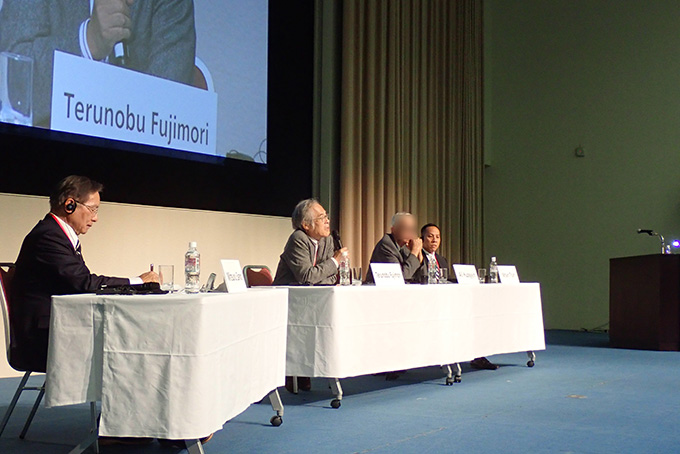 |
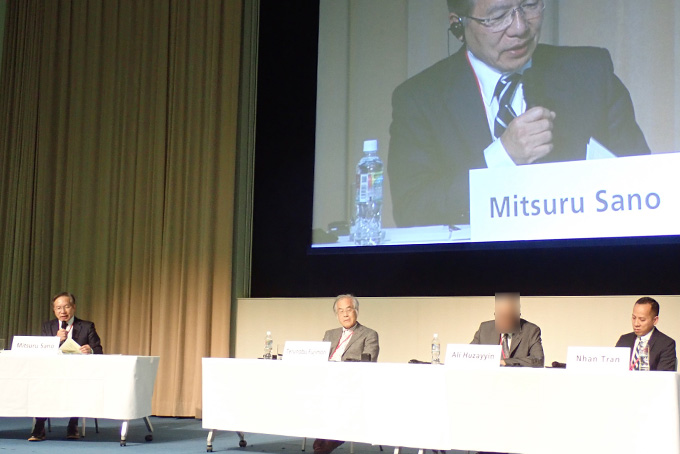 |
Prof. Mitsuru Sano, Moderator and IATSS counsellor, Nihon University, started the discussion by highlighting the topic of comparative cultures of traffic. In Japan, as traffic culture has changed since the times of Nara, so it has around the world in difference spheres of economic and cultural influence. Prof. Sano introduced the speakers of Prof. Huzayyin and Dr. Tran who are to give their own perspectives. Dr. Fujimori gave his own view of countries and traffic, and the gap between private and public. This gap may also exist between traffic regulations and the public. Prof. Sano considered this gap to be needed and where culture was born.
Prof. Ali Huzayyin, Cairo University, explained “traffic culture” from the “other side of the coin”; i.e., the “none road user” related stakeholders practice culture. Traffic safety is intimately related to traffic culture of road users, and the inhabitants living nearby; their features, behavior and performance. However, traffic culture and its impact on safety are not attributed only to the road user. “Practice culture” of the traffic related stakeholders other than the “road users”, e.g., the culture of practice in traffic engineering, the practice culture of city/national authorities and of policy and decision circles, and of education institutions and the media, all affect road safety. This particularly prevails in developing countries, where such holistic view is neglected, and focus is solely directed to road users within the larger system.
Some developing countries lack qualified traffic engineers in the city authority; either the job does not exist, or if it exists traffic engineers lack independence from authorities or their role is taken over by others, e.g., city planners, road engineers, traffic police, etc. Many cities, therefore, do not act professionally on traffic engineering. Related policy circles are unaware of traffic engineering profession and support non-specialised policies and legislation on traffic management. School education teaching material lacks review and advice on traffic safety from specialised traffic engineers, and the media supports opinions from non-specialists (on traffic engineering), thus, misinforming the general public and the authorities. Consequently, such incompetent practice culture by many traffic related stakeholders, other than the road user, has impacts on traffic safety.
With the above in mind, road accidents in developing countries can be directly attributed to; incompetent traffic culture leading to “voluntary” ill behavior of the road user and incompetent practice culture of traffic related stakeholders other than the road user leading to “forced” ill behavior of the road user. Voluntary ill behavior reflects the engagement in dangerous road use; this also occur in some cities of developed countries. Forced ill behavior is obligatory engagement in dangerous road use. This is due to, for example, lack of specialised road and traffic engineering design, insufficient sidewalks, e.g., narrow width, bad surface condition and/or occupied (by merchants, cafes, parking, etc.), undersigned humps, extended bus/truck driver hours, etc. Prof. Huzayyin showed photos of voluntary and forced ill behavior in some cities, stressing that eliminating inappropriate practice culture of the traffic related stakeholders other than the road user, is more difficult than rectifying inappropriate traffic culture of the road user.
Changing mindset and traditional non-professional practice of stakeholders (e.g., city top management and politicians, traditional practitioners, etc.) in developing countries require many actions by many entities. For example, Syndicates of Engineers should insist on the needed change and take appropriate action to protect and sustain the specialised traffic engineering profession and professionals. Universities, through their transport and traffic engineering and planning scholars, should train young traffic engineers, raise awareness of, and demonstrate to, city managers and politicians that employing those engineers and protecting their independence is fundamental for reducing traffic problems and improving road safety. Relevant international technical assistance must support professional practice by local traffic engineering experts and be adaptive to local conditions. Essentially, the aid should be country driven, not donor imposed. This needs awareness of city management and politicians.
Changing traffic culture of road users requires traffic engineers to design and implement awareness “Programmes” for improving road user behavior. City and national governments should provide sustained finance and the media should support sustained dissemination of these programmes. NGOs, civil societies and volunteering senior citizens and youth must be allowed to perform sustained active ‘on site’ role with the people; to explain appropriate road use behavior aiming at improving traffic culture and road safety.
Dr. Nhan Tran, WHO, spoke of traffic safety from a global perspective. At present, the public health issue of road deaths kills more people than HIV/AIDS and certain diseases, resulting in 2.5 percent of total deaths. The SDGs and other UN instruments have become powerful tools to implement solutions to road safety. Likewise, the development of the science of road traffic deaths has been seen to progress. Both of these should contribute to a reduction.
Yet, the data show the global health estimates show very little progress. The path to reach the SDGs goal and reduce the number of deaths on the road is blocked by a lack of implementation to known solutions. Why is implementation so difficult? This is a difficulty experienced in many fields not just road traffic safety.
Implementation is about change, where as it is often viewed as something to be done in addition to other objectives. The gap between knowledge and actions is often seen as a way to solve the problem. Whilst this may be true, change is a process not an event and so it takes time. Another factor is that implementation occurs in systems and it is not independent from other systems.
The correct solutions would not only address problems, but address the whole solution. To reach this systems approach of solving road traffic deaths, we should consider changing our view of road safety from accidents, to a whole safe system. The environment and system as a whole can be changed and these road deaths are preventable. Roads safety should not be talked of as if it is a fight against risk factors, but consider talking about safety as a value. Humanity does not value road safety as important as flight safety. So, by thinking of safety as a value not interventions we can reduce road traffic deaths.
The moderator, Prof. Sano, reflected on the panel’s presentations, focusing on safety as a value which secures the asset of human life. He mentioned that Dr. Fujimori’s comments on the ambiguous gaps can also been seen in bicycles, which obey different norms than that of automobiles. The rules of automobiles were developed by the West and are applied to vehicles and bicycles alike. In Japan, however, bicycles are treated as a means of transport and supplementary to walking. Therefore, bicycles can travel in both directions and also on sidewalks. This different and ambiguous treatment of bicycles, despite being vehicles, may be useful in preventing accidental contact.
Dr. Fujimori stated that people often place signs posters in public spaces to improve their aesthetics. Traffic safety could be improved by reconsidering pedestrian walkways, which should be regarded as a positive place. If this can be done interest in traffic could be enhanced. Making pedestrian spaces attractive would encourage interest from children and therefore improve road safety as a whole as these generations grow up. Regarding plants, the gutter space in Japan is a private part of the road in which often plants are grown. In other countries like Spain, people proudly present their plants grown on the side of the walkway. This improves the overall enjoyment of the road users. This may cause interest from further afield, and then inspire other areas and cities. This could expand the idea of the “plaza” to all pedestrian walkways.
The moderator, Prof. Sano, summarized Dr. Fujimori’s points of focusing on the prevention of traffic accidents by instilling an approach to traffic safety that is based on the idea of gaps between pedestrian roads and public spaces, and posed Dr. Fujimori’s ideas to Dr. Tran.
Dr. Tran agreed that environment affects road user safety. Reassigning areas for pedestrians like in New York City, by creating more walking spaces, can encourage overall health and is an important way to respond to the problem.
From a different perspective, Prof. Sano asked Prof. Huzayyin about enhancing traffic safety through traffic engineering specialists. In particular, what roles do organizations play in this?
Prof. Huzayyin replied that city authorities must employ specialised traffic engineers, protect their independence and apply their designs on traffic management measures and schemes that should consequently lead to better safety. NGOs due to their community connections, and grants they receive, have unique position that city governments do not. They already work well on health, social development, etc., and must be asked to engage in transmitting traffic and road safety culture to the community and the same role is to be played by the volunteers from old age people and youth.
Prof. Sano asked the panel a question about the cultural aspect of traffic safety in various countries worldwide. Survey data shows that regarding pedestrian crossings, pedestrians from developed countries would often cross at areas that were not demarcated crossings. However, in developing countries the outcome was different, with respondents answering that they almost never cross at such areas. It was interesting to note that survey data received on traffic safety was usually different to actual behavior due to the social norm in developing countries that rules must be obeyed and a strong desire among the respondents of wanting to be seen to be doing so. In other words, these respondents were consciously led to give answers that differed from reality. As such, how strictly or weakly rules are enforced in a particular country affect the outcome of surveys which are used to gather the data. Both developed countries and developing countries face similar safety issues, regardless of their level of development. Even when people know it is dangerous, they will cross the road where there is no crossing, if they personally determine that it is safe to do so. What is the use of the rules, if we cannot follow them in everyday living? In some circumstances is it normal to not follow traffic laws and rules. How can we improve or respond to this situation?
Prof. Huzayyin explained that crossing the street where there is no pedestrian crossing, occur in developed and developing countries. As such it is an issue of human nature. Because the media, and NGOs, are closest to the people due to their outreaching nature, they are in the best position to educate people. Cities and national governments must facilitate their work.
Dr. Tran remarked on Sweden’s idea of Vision Zero, humanity is bound to make mistakes, our systems should circumvent this. Acknowledging human beings’ imperfect nature is vital when creating our systems. This should be the focus not just defining it as ill behavior.
Prof. Huzayyin reiterated that acknowledging the human beings’ imperfect nature, confirms what he mentioned in his presentation about voluntary and forced ill behavior of road users. Particularly because the latter is caused by incompetent practice culture of none road user stakeholders which result in bad road system and, hence, serious impact on safety, it is important to eliminate such practice culture and change the mindset of those stakeholders.
Prof. Sano said that the teaching of traffic safety must also incorporate the teaching of geographic information systems (GIS). Professionals involved with the traffic safety of local communities should use data from GIS-based statistical analysis and mapping when formulating traffic safety policies, in order to reflect local people’s everyday behavior in traffic safety education. GIS should also be utilized by policy makers. GIS data should be widely used. Prof. Sano then asked for comments from the panel.
Prof. Huzayyin mentioned that cities either have no data or have it, but it is inappropriate or outdated, or they do not use it and do not allow it for traffic engineering professionals and researchers to utilize for design and for accident analysis for support of policy decisions. Therefore, data must be appropriate, continuously updated and shared to professionals, academics and researchers.
Dr. Tran said that collecting the data on road traffic deaths is often collected by different sources and this leads to incomplete sources. Many countries have data from hospitals, police and the city, however this data needs to be collected. The magnitude of the problems is often ignored. The differences between police data and health data can be drastic, this difference in reporting can lead to politicians ignoring the real size of the issue.
Prof. Huzayyin agreed and added that the definition of injuries and fatalities should be unified to create meaningful data and better understanding of the issues.
Prof. Sano asked about the method of use of this inappropriate data. The best practice would be to link data sets. He suggested that the best course of action would be to create links to the traffic safety data that is currently being collected.
Prof. Huzayyin stated that it is necessary a need to simplify the data at point of collection and the stakeholders involved should take advantage of new ‘big data’ technology in collecting, processing and transmitting the data electronically. Governments should realize that spending little amount to invest in this technology would drastically change the situation to the better.
Dr. Tran agreed with the removal of paper-based systems of data management, and instead suggested using mobile phones. This kind of innovation is definitely available for low and middle income countries.
Prof. Sano opened the discussion to questions and comments from the audience.
Mr. Sato from Organizations Rethinking Car Society, mentioned that the panel discussed the creation of specialists in various countries, the low death rate in advanced countries, and other success stories. However, due to these successes vital areas are overlooked. Road traffic accidents rarely receive as much attention from the media as diseases such as HIV/AIDS. The victims of road traffic safety themselves are ignored and must be commemorated. Dr. Tran asked what the enemy of traffic safety is and suggested that perhaps in road safety, there is no enemy. The data is important but each victim must be addressed individually, this could change the mindset of people.
Prof. Sano stated that the panelists will address the audience’s comments in their summaries and called for further questions or comments.
Mr. Kitahara from Safety of Automotive Engineers of Japan, highlighted the futile nature of addressing traffic safety. A wide extensive response was given by the panelists to the use of data and improvements of the system. However, government agencies will hide data to avoid blame. Reducing accidents by all means is the only way to solve the problem, this includes punitive measures. This being said, some cultures have a wider acceptance of mistakes. Moreover, trial and error could lead to continuous improvement.
Prof. Sano highlighted the World Day of Remembrance for Road Traffic Victims, and the lack of a one fits all solution and the need for the panel to ruminate on these. Prof. Sano then introduced the concluding comments from the discussion panel.
Dr. Tran responded by looking at the story from the audience about road safety, by stating that in the future society will not allow people to walk in such close proximity to danger. Mankind can solve the problem by rethinking our whole approach to safety and spaces. Parks were used in 1960s Japan to improve road safety by taking children away from roads and redefining spaces.
Prof. Huzayyin summarized that the traffic related stakeholders in developing countries need to truly understand that by the incompetent traffic related practice culture, they force people to make mistakes on the road. In the same time, they should not ignore that the people make voluntarily mistakes on the road as well. In addition, cities should employ professional traffic engineers, secure their independence and support their traffic engineering designs and analysis in support of proper policies and solutions. Stakeholders should introduce advanced big data technologies, which is inexpensive and comprehensive. Awareness of traffic culture and road safety is a role for schools, NGOs, the media and cities to make the whole society aware of the size of the issue. Aid to cities in developing countries on road safety should be practical, cater for local conditions and stem from the city; not imposed by the aid agency. As such, more cooperation is needed between the global north and south and, also, between global south and south. He finally, expressed his thanks and appreciation to IATSS and the organizers of this important well planned and well conducted forum.
Dr. Fujimori showed his respect for the concept of having no enemy.
Prof. Sano closed the discussion by thanking the panel for their discussion and the audience for their time. He expressed his hope for a safe road traffic environment in the future as it is our right.
Closing Address
Satoshi Kamada
IATSS Executive Director
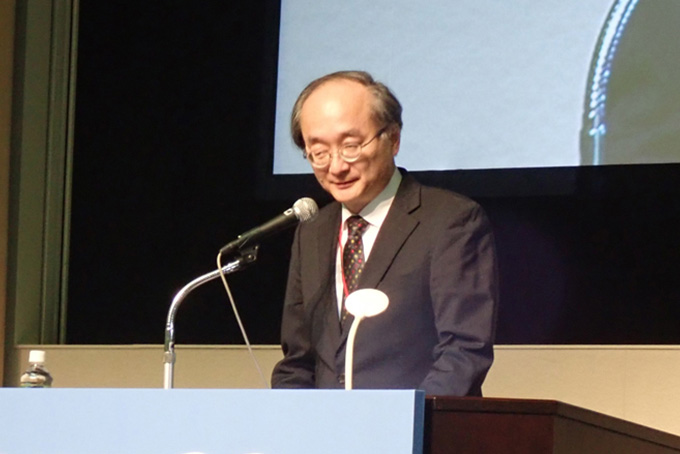
Mr. Satoshi Kamada, Executive Director of IATSS, began the closing remarks by thanking the participants and the speakers for their cooperation, as well as the audience for their active involvement with the discussion. Highlighting the importance of understanding differences in social background and cultures across different countries and regions, he explained that each year, GIFTS looks at matters related to traffic and safety from a comparative culture perspective and that on 3 November, a workshop will be held on a comparative study of traffic safety.
Lastly, Mr. Kamada reported that IATSS is promoting over 10 research projects, the results of which will be announced in the regular reporting meeting in April, before concluding his remarks.

